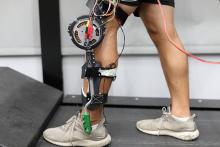
Aaron Young and Greg Sawicki approach robotics from different angles, but they share the same goal- they want to develop wearable robotic devices that can help people maintain or increase their mobility. Together their labs in Georgia Tech’s George W. Woodruff School of Mechanical Engineering are laying the groundwork for a range of devices that could help injured athletes, children, stroke patients, the elderly, and amputees gain more independence and move with greater comfort and ease.
“My goal in the lab is to make sure that people can do what they want to do as long as they want to,” says Sawicki. “That might be a big challenge, but it’s a straightforward guiding principle- make people happy by allowing them to keep moving.”
Aaron Young approaches these challenges as a controls specialist focused on how the human body can interface with a robotic device. The human body processes countless signals every time a person moves, so he is focused on translating those neural signals into commands for a range of exoskeletons and prostheses that can perform as seamlessly as if they were a part of the body.
Video Summary: https://youtu.be/8ZJDIDG093s
